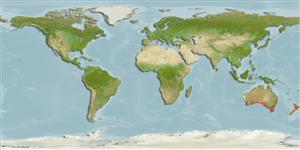Common names from other countries
Classification / Names / Names
народные названия | синонимы | Catalog of Fishes (gen., sp.) | ITIS | CoL | WoRMS
Environment: milieu / climate zone / depth range / distribution range
экология
; пределы глубины 1 - 125 m (Ref. 74426). Subtropical
Indo-West Pacific: Australia.
Length at first maturity / Size / Вес / Возраст
Maturity: Lm ? range ? - ? cm
Life cycle and mating behavior
половая зрелость | размножение | нерест | икра | Fecundity | личинки
Members of the order Amphipoda are gonochoric and sexually dimoprhic (males larger than females). Mating behavior: Males locate potential partners with the aid of their antenna to detect the pheromones released by the females; the male then rides or carries the female until the latter is ready to molt. When the female is ready, the male pushes the sperm into the marsupium and releases the female afterwards. A few hours later, the female releases her eggs into the marsupium for fertilization. Life cycle: Eggs are brooded in the marsupium. Eggs hatch into juveniles and remain in the marsupium for a few days. Each species undergo 20 molts at most, i.e., 1-year long life cycle.
Основная ссылка
ссылки | координатор | соавторы
Lowry, J.K. 2007. (Ref. 74426)
Статус Красного Списка МСОП (Ref. 130435: Version 2024-1)
Статус СИТЕС (Ref. 108899)
Not Evaluated
Not Evaluated
Угроза для людей
Harmless
Использование человеком
| FishSource |
инструменты
дополнительная информация
Возраст/Размеры
рост
Зависимость между длиной и массой тела
Зависимость между длинами
морфология
личинки
численность
ресурсы в Интернет
Estimates based on models
Preferred temperature
(Ref.
115969): 14.6 - 20.1, mean 17.1 (based on 298 cells).
